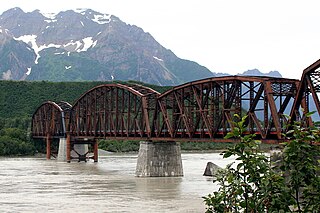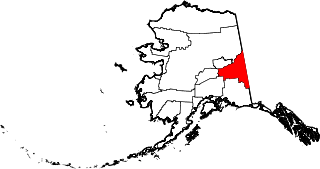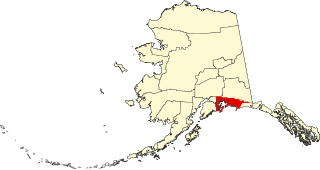
Southeast Alaska, often abbreviated to southeast or southeastern, and sometimes called the Alaska(n) panhandle, is the southeastern portion of the U.S. state of Alaska, bordered to the east and north by the northern half of the Canadian province of British Columbia. The majority of southeast Alaska is situated in Tlingit Aaní, much of which is part of the Tongass National Forest, the United States' largest national forest. In many places, the international border runs along the crest of the Boundary Ranges of the Coast Mountains. The region is noted for its scenery and mild, rainy climate.

Ketchikan is a city in and the borough seat of the Ketchikan Gateway Borough on Revillagigedo Island of Alaska. It is the state's southeasternmost major settlement. Downtown Ketchikan is a National Historic Landmark District.

Wrangell is a borough in Alaska, United States. As of the 2020 census the population was 2,127, down from 2,369 in 2010.

The Miles Glacier Bridge, also known as the Million Dollar Bridge, was built in the early 1900s across the Copper River fifty miles from Cordova in what is now the U.S. state of Alaska. It is a multiple-span Pennsylvania truss bridge which completed a 196-mile (315 km) railroad line for the Copper River and Northwestern Railway, built by J. P. Morgan and the Guggenheim family to haul copper from the old mining town of Kennicott, now located within the Wrangell–St. Elias National Park and Preserve, to the port of Cordova. It earned its nickname because of its $1.4 million cost, well recouped by the about $200 million worth of copper ore which was shipped as a result of its construction.

The Copper River or Ahtna River, Ahtna Athabascan ‘Atna’tuu, "river of the Ahtnas", Tlingit Eeḵhéeni, "river of copper", is a 290-mile (470 km) river in south-central Alaska in the United States. It drains a large region of the Wrangell Mountains and Chugach Mountains into the Gulf of Alaska. It is known for its extensive delta ecosystem, as well as for its prolific runs of wild salmon, which are among the most highly prized stocks in the world. The river is the tenth largest in the United States, as ranked by average discharge volume at its mouth.

Wrangell–St. Elias National Park and Preserve is a United States national park and preserve in south central Alaska. The park, the largest in the United States, covers the Wrangell Mountains and a large portion of the Saint Elias Mountains, which include most of the highest peaks in the United States and Canada, yet are within 10 miles (16 km) of tidewater, one of the highest reliefs in the world. The park's high point is Mount Saint Elias at 18,008 feet (5,489 m), the second tallest mountain in both the United States and Canada. The park has been shaped by the competing forces of volcanism and glaciation, with its tall mountains uplifted by plate tectonics. Mount Wrangell and Mount Churchill are among major volcanos in these ranges. The park's glacial features include Malaspina Glacier, the largest piedmont glacier in North America, Hubbard Glacier, the longest tidewater glacier in Alaska, and Nabesna Glacier, the world's longest valley glacier. The Bagley Icefield covers much of the park's interior, which includes 60% of the permanently ice-covered terrain in Alaska. At the center of the park and preserve, the boomtown of Kennecott exploited one of the world's richest deposits of copper from 1903 to 1938. The abandoned mine buildings and mills comprise a National Historic Landmark district.

Northwest Seaport Maritime Heritage Center is a nonprofit organization in Seattle, Washington dedicated to the preservation and interpretation of Puget Sound and Northwest Coast maritime heritage, expressed through educational programs and experiences available to the public aboard its ships. The organization owns three large historic vessels docked at the Historic Ships' Wharf in Seattle's Lake Union Park; the tugboat Arthur Foss (1889), Lightship 83 Swiftsure (1904), and the halibut fishing schooner Tordenskjold (1911). These vessels are used as platforms for a variety of public programs, ranging from tours and festivals to restoration workshops and vocational training.

Yakutat Airport is a state-owned public-use airport located 3 nautical miles (6 km) southeast of the central business district of Yakutat, a city and borough in the U.S. state of Alaska which has no road access to the outside world. Airline service is subsidized by the Essential Air Service program.

Merle K. (Mudhole) Smith Airport is a state-owned public-use airport located 11 nautical miles southeast of the central business district of Cordova, a city in the Chugach Census Area of the U.S. state of Alaska which has no road access to the outside world. Airline service is subsidized by the Essential Air Service program.

Gustavus Airport is a state-owned public-use airport located in Gustavus, a city in the Hoonah-Angoon Census Area of the U.S. state of Alaska. Scheduled airline service is subsidized by the Essential Air Service program.

Cape Decision is a lighthouse located on Kuiu Island adjacent to Sumner Strait in Southeast Alaska.

The Purple Point-Stehekin Ranger Station House is a National Park Service ranger residence located in the Lake Chelan National Recreation Area of northern Washington. The building was built at Purple Point above Lake Chelan in the small, unincorporated community of Stehekin, Washington. It was originally constructed by the United States Forest Service to serve as the residence for the Stehekin District ranger. The Forest Service later converted it into a summer guard station. The building was transferred to the National Park Service in 1968 when the Lake Chelan National Recreation Area was established. The Purple Point-Stehekin Ranger Station House is listed on the National Register of Historic Places.

This is a list of the National Register of Historic Places listings in Southeast Fairbanks Census Area, Alaska.

The Cordova Post Office and Courthouse is a historic government building at 612 2nd Street in Cordova, Alaska. It is an L-shaped building, its structure determined in part by the site, which is set into a hill. At the front it is three stories in height and five bays wide, with its main entrance in the leftmost bay, sheltered by a modern solid canopy. The exterior is finished in concrete. The interior originally had the post office on the first floor, a courtroom and judge's chambers on the second floor, and other court offices and a law library on the third floor.
The Judith Ann is a riverboat that historically plied the Stikine River in southern Alaska and western British Columbia. Built in 1950, the wooden-hulled boat operated on the river between 1950 and 1970, was the last boat to offer scheduled service on the river, and is the only surviving service watercraft to ply the river. She operated between Wrangell, Alaska and Telegraph Creek, British Columbia. She is now owned by the Stikine River Historical Foundation, and was listed on the National Register of Historic Places in 2004.
The F/V Charles W, also known as Annie J Larsen, is a historic fishing schooner anchored in Petersburg, Alaska. At the time of its retirement in 2000, it was the oldest fishing vessel in the fishing fleet of Southeast Alaska, and the only known wooden fishing vessel in the entire state still in active service. Launched in 1907, she was first used in the halibut fisheries of Puget Sound and the Bering Sea as the Annie J Larsen. In 1925 she was purchased by the Alaska Glacier Seafood Company, refitted for shrimp trawling, and renamed Charles W in honor of owner Karl Sifferman's father. The company was one of the pioneers of the local shrimp fishery, a business it began to phase out due to increasing competition in the 1970s. The Charles W was the last of the company's fleet of ships, which numbered twelve at its height. The boat was acquired in 2002 by the nonprofit Friends of the Charles W.

The McCarthy General Store is a historic former general store and boarding house at Kennecott and Skolai Streets in the small community of McCarthy, Alaska, located in the heart of Wrangell-St. Elias National Park and Preserve. At two stories in height and measuring 47 by 56 feet, it is McCarthy's largest building, and one of its oldest. It was built in 1914, during the mining boom at nearby Kennecott. The store occupied the ground floor of the building, and the upper level had eleven rooms for boarders. The building was abandoned after the mining boom ended in the 1930s,.

Libby's No. 23 is a historic sail-powered fishing vessel, now on display at the Lake Clark National Park and Preserve visitors center in Port Alsworth, Alaska. Built in 1914, she served in the salmon fishery of Bristol Bay until about 1951, owned by the Libby's cannery and worked by two-man crews. She is 29 feet 6 inches (8.99 m) long, with a beam of 9 feet 2 inches (2.79 m) and a depth of 4 feet (1.2 m). Its bow and stern are roughly the same shape, giving the style its name. Despite its use for freight and recreation between 1953 and 1997, the boat has retained much of its original equipment, and was fully restored by the National Park Service between 1998 and 2005, acquiring replacement parts from similar boats and removing an added motor. It is normally rigged with a mainsail and spritsail, but these are only raised when the boat is taken out of its custom-built boathouse.

USCGC Elderberry (WLI-65401) is an inland buoy tender of the United States Coast Guard. She is based at Petersburg, Alaska and is responsible for maintaining aids to navigation. Her efforts are focused on waterways that are especially shallow or restricted.

This is a list of the National Register of Historic Places listings in Chugach Census Area, Alaska.






















